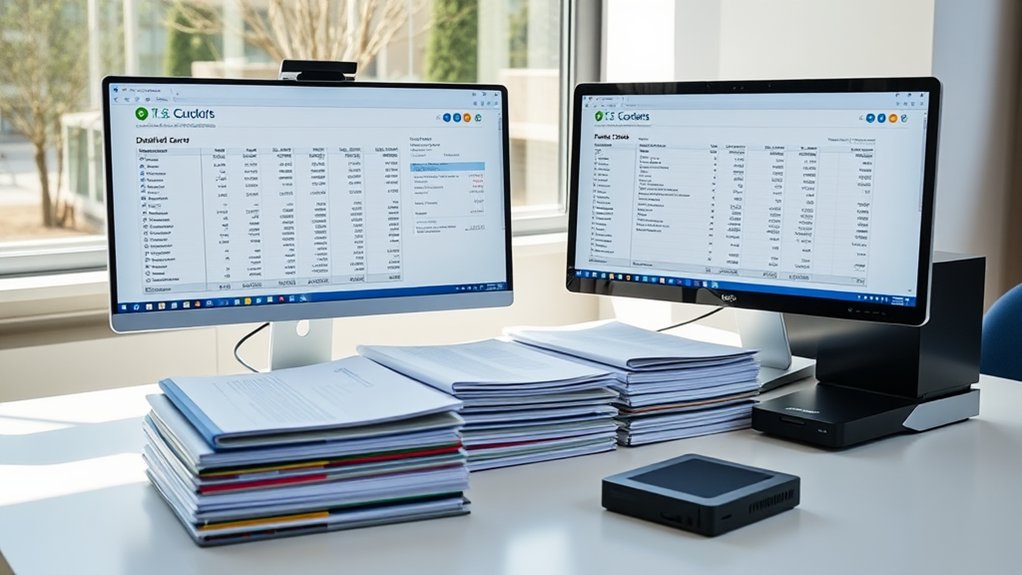Integrating your bookkeeping with donor management systems delivers multiple operational advantages for nonprofits. You’ll eliminate manual data entry errors through automated synchronization, while gaining real-time financial analytics and donor engagement metrics. The integration reduces processing time by up to 70% and maintains clear audit trails. Plus, you’ll benefit from sophisticated reporting capabilities that connect donation patterns to operational costs. The full scope of integration benefits extends far beyond these initial advantages.
Enhanced Data Accuracy and Error Reduction

When nonprofit organizations integrate their bookkeeping and donor management systems, they substantially reduce manual data entry and transcription errors. I’ve found that automation eliminates double-entry workflows, synchronizing financial records with donor data in real-time. This integration creates a single source of truth, preventing discrepancies between systems.
Streamlined Financial Reporting and Analysis
The integration of bookkeeping and donor management systems revolutionizes financial reporting capabilities for nonprofits. I’ve found that this convergence enables you to generate sophisticated financial analyses instantly, leveraging real-time data from both systems.
You’ll gain immediate access to donor lifetime value metrics, program-specific ROI calculations, and expansive campaign performance analytics. I can attest that the system automatically maps donation patterns to operational costs, creating dynamic forecasting models for strategic decision-making.
When you merge these systems, you’ll eliminate manual report reconciliation and activate automated dashboard capabilities that transform raw data into actionable intelligence for your board and stakeholders.
Real-Time Donor Engagement Metrics

Building upon these integrated financial insights, real-time donor engagement metrics offer unprecedented visibility into supporter behaviors and interactions. I’ve found that monitoring key performance indicators like giving frequency, average donation size, and digital engagement rates enables me to identify trends and pivot strategies instantly. By tracking real-time metrics, I can analyze donor lifecycle stages, segment supporters based on their engagement levels, and trigger automated responses to specific actions. The integration lets me correlate financial data with engagement patterns, revealing which outreach methods drive the highest ROI and empowering data-driven decisions about resource allocation.
Time and Cost Savings Through Automation
Integrating bookkeeping with donor management systems dramatically reduces manual data entry and administrative overhead through intelligent automation. I’ve found that automated synchronization between these systems can cut processing time by up to 70%, eliminating duplicate entries and reconciliation errors. You’ll save on staffing costs as the system handles routine tasks like receipt generation, pledge tracking, and financial reporting. By leveraging API connections, your donation records instantly update your accounting ledgers, ensuring real-time accuracy. Your team can redirect their focus from repetitive data entry to strategic donor relationships and mission-critical activities.
Improved Compliance and Audit Readiness

I want to explore how integrated bookkeeping and donor management systems strengthen your organization’s compliance and audit preparedness. When your financial data and donor records exist in one unified system, you’ll maintain a clear audit trail that documents every transaction, donation, and interaction while enhancing your ability to track grant requirements and milestones. These integrated systems also enable you to generate thorough regulatory reports quickly, reducing the stress and complexity of audit preparations.
Clear Audit Trail Documentation
When nonprofit organizations maintain integrated bookkeeping and donor management systems, they create an automatic, exhaustive audit trail that documents every transaction and interaction. I’ve found this integration enables you to track every donor touchpoint, from initial contact through multiple giving cycles. You’ll have instant access to detailed records showing how funds flow from donation to allocation, including gift processing, acknowledgment dates, and fund disbursement.
I can confirm that this all-encompassing documentation empowers you to demonstrate your organization’s accountability. You’ll maintain time-stamped records of approvals, changes, and communications that prove compliance with regulatory requirements and donor restrictions.
Enhanced Grant Tracking Records
The thorough audit trail proves especially valuable for grant tracking and compliance. I can help you maximize oversight of your grant funds through integrated systems that connect financial data with program outcomes.
Key benefits of enhanced grant tracking include:
- Real-time monitoring of grant spending against budgeted allocations and milestones
- Automated reporting that links expenditures directly to funded program activities
- Immediate access to supporting documentation for all grant-related transactions
This integration empowers you to maintain precise control over restricted funds while demonstrating your organization’s excellent stewardship to grantmakers. You’ll stay prepared for funder reviews and maintain complete visibility into grant performance metrics.
Streamlined Regulatory Reporting
By integrating your bookkeeping with donor management systems, you’ll streamline regulatory compliance and enhance audit preparedness through automated documentation. I’ve found that this integration automatically generates audit trails, meeting IRS requirements for nonprofit reporting. You’ll gain instant access to Form 990 data points, charitable contribution records, and donor acknowledgment documentation.
The system cross-references financial transactions with donor records, ensuring accurate reporting of restricted funds and program allocations. I recommend leveraging built-in compliance checks that flag potential issues before they become audit concerns. This proactive approach reduces your risk exposure while maintaining your organization’s reputation with regulatory bodies.
Better Strategic Planning and Decision Making
Strategic decisions in nonprofit organizations rely heavily on accurate financial and donor data integration. I’ve found that combining bookkeeping with donor management systems empowers you to make data-driven decisions that maximize your organization’s impact.
- Analyze giving patterns alongside financial trends to identify ideal fundraising timing
- Project cash flow requirements by correlating donor retention rates with operational expenses
- Execute targeted growth strategies by matching donor segments with program performance metrics
When you integrate these systems, you’ll gain real-time insights that strengthen your strategic planning. This all-encompassing view enables you to allocate resources more effectively, scale programs strategically, and build sustainable long-term growth for your organization.









